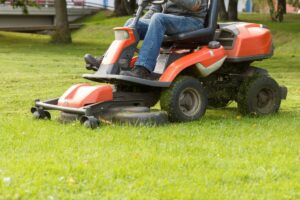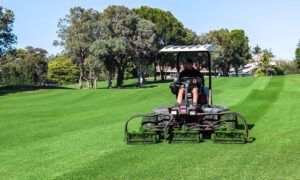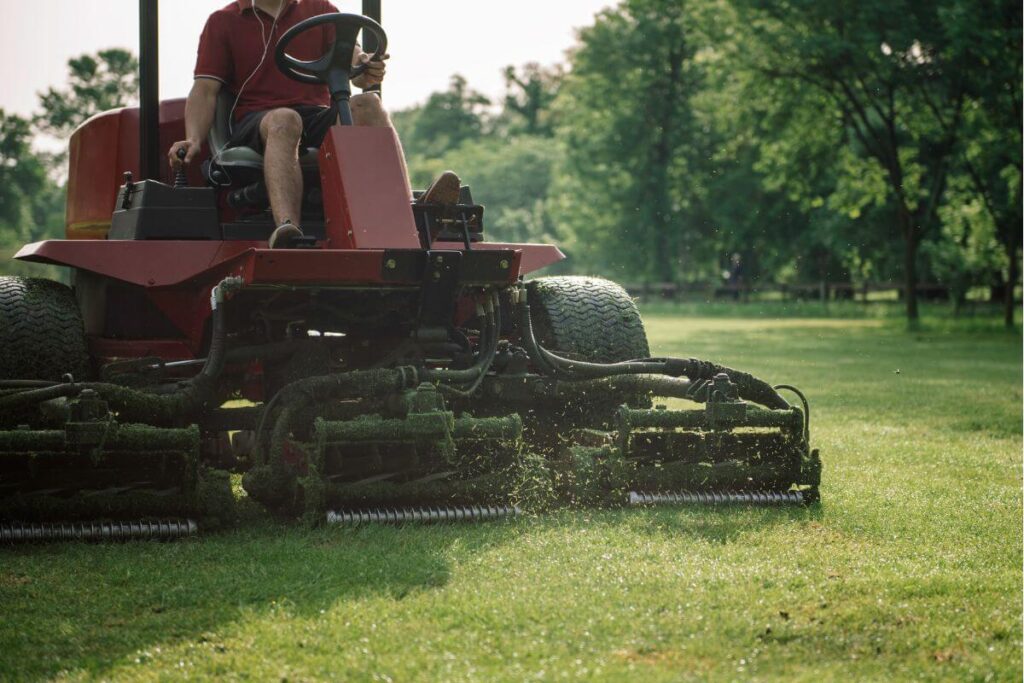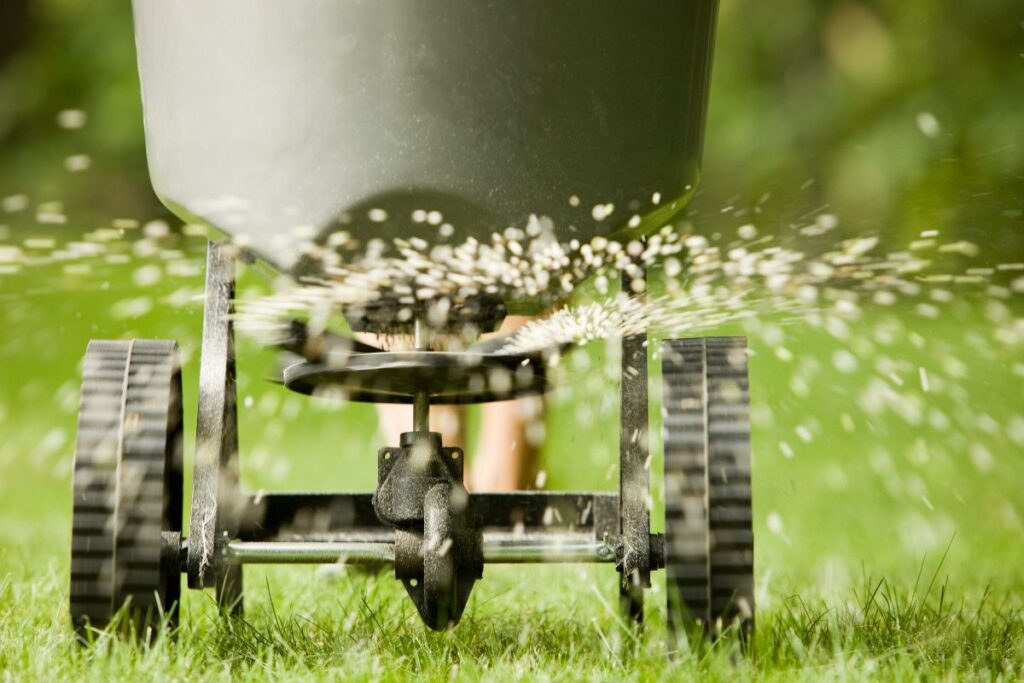The objective when cutting fairways is to provide the golfers with a consistent playing surface, and consistency can be provided only when the grass is mowed regularly and with expertise.
The height of cut must be sufficiently low to ensure that there is no grass between the ball and the clubhead at the time of impact.
The ball should sit up perfectly on closely groomed turf. Low-handicap golfers and golf professionals prefer tight lies with very little grass between the ball and the earth. From such lies they make the golf ball spin when it lands on the green.
Higher-handicap golfers tend to be happier with more turf under the ball so that they can scoop the ball with a fairway wood or a low iron.
Achieving these conditions for all types of golfers, of course, is nearly impossible, and we must also compromise, somewhat, by taking into account the needs of the grass.
The following factors should govern the decisions that prudent superintendents must make when cutting fairways:
Table of Contents
7 Tips For Cutting Fairways
1. The Height Of Cut
The height of cut on fairways should be 5/8 inch or less. Golfers across the world over demand closely cropped turf on the fairways. They want tight lies and lots of roll. There are certain species of grass that do not tolerate such a short cut and the cutting height needs to be raised.
Such is the case on bluegrass fairways in the northern zone. Not every golf course wants or needs close-cut fairways. Various bluegrass mixes make an excellent turf that is quite playable for even the most discriminating golfers. The cool season fescues and ryes are also often cut at below 1 inch.
Fairways that are overseeded with rye and Poa trivialis in the southern states during the winter season are also cut at the 1/2-inch height. Superintendents who, for whatever reasons, wish to grow 1-inch grass on their fairways should expect to struggle with their bosses, committees, and the golfing community.
At many golf courses fairways are cut at less than 1/2 inch. Both bent and Bermuda grasses can tolerate the lower height with minimal ill effects.
Although visually appealing, maintaining a lower height of cut may not be a cost-effective approach for many golf course budgets. Fairways that are cut extremely short will virtually have a turf quality that is similar to that of the greens.
2. The Frequency Of Cut
The frequency of cut is typically determined by the rate of growth of the turf. The faster the grass is growing, the more often it needs to be cut.
When the grass is fertilized regularly and growing actively, it may need to be cut every other day. Many superintendents cut fairways Mondays, Wednesdays, and Fridays. At times, the grass is growing so vigorously that three times per week is just not enough.
Arrangements then have to be made to cut the fairways on weekend mornings or to add an extra dayto the weekly schedule. The recent introduction of growth retardants has significantly reduced the rate of growth on fairways and the need to cut so often.
Clipping disposal has become much less of a problem on fairways treated with growth retardants for the simple reason that substantially fewer clippings are removed.
3. Pattern Cutting
Pattern cutting on fairways is a matter of personal choice, and done with some degree of imagination, or television-fed golfers will soon find a superintendent who can provide picture-perfect cut grass.
Straight cutting lines on fairways are as important as they are on greens and tees. The age-old method of cutting toward a tree on the horizon will provide a straight line every time.
Of course, there are courses without trees and in such cases another feature, such as a focus point, will do just fine. Sometimes, instead of cutting a straight line, superintendents have been known to follow the contour of a water hazard.
This makes for an interesting deviation from the more commonly used checkerboard pattern.
4. Contouring
With target golf and lightweight mowing machines came contouring of the fairway edge. The contrast between the short, light green fairway and the much darker and longer rough was startling.
Sometimes there is an intermediate cut, or step cut, to make the shapes and the shading even more interesting and pronounced. Golfers like the transitional cut, and tournaments often specify that it be implemented.
It reduces the severity of the penalty between a heavenly lie on the fairway and a difficult shot from an ankle-deep rough.
Over time, the repeated cutting of fairways, as with greens, often results in the fairways losing their shape. The best way to correct this situation is to employ an experienced golf course architect to recreate fairways with sweeping curves.
It takes a special talent, as well as expert knowledge, to make the curves suit the needs of the game of golf. Architects are authorities on where fairways should be cut narrow or wide, and where they should bell out or crimp in.
The preferred solution to make these corrections in design is to hire an architect, but if this is not possible, then there are two other methods of restoring the contour that should be considered.
The first would be to use a long hose to form the proposed outline of the new curve, and the second method is to place stakes outlining the proposed new form. In either case, after deciding the proper location of the new curves, white paint should be applied to outline the proposed contour.
Cutting a strip of sod along the intended curved line and replacing the extended fairway area with similar fairway turfgrass will ensure that the new curves will be clearly visible for many years to come.
5. Cutting The Aprons/Collars
An extension of the fairway, the short turf that surrounds the green and sometimes described as collars, aprons, and frogs’ hair is usually cut at an even lower height than the fairway. At some courses the collar may just be one cut around the outside of a green, usually at a height slightly higher than the green and somewhat lower than the fairway.
At other courses, the collar, which now becomes an apron, is extended somewhat, especially at the front where it is cut in such a fashion that it blends in with the fairways. Yet another method involves using a walk-behind greens mower for the collar and the transition zone between the fairway and the green.
Turf maintained in this fashion encourages golfers to putt from these areas. Superintendents all have their own particular preferences and are usually assisted by their green committee or management company advisors in determining what’s best for the golfers.
6. Sprinkler Heads
Mower operators should be wary of sprinkler heads that they are apt to encounter when cutting the grass. Sprinkler heads are ideally leveled so that the operator can drive over the top without worrying about cutting a sprinkler instead of the grass.
If necessary, slow down on the throttle and ever-so-gently glide over the sprinkler, but if the sprinkler head is higher than the grass, then there is no choice but to cut around the obstacle.
Operators should report all improperly adjusted heads to the superintendent, especially raised sprinkler heads that should be adjusted immediately before disaster strikes.
When a mower swallows a sprinkler, all sorts of horrible things are apt to happen. At best, the mower will just take a bite from the collar of the sprinkler—no big deal, just an ugly scar.
At worst, the sprinkler will be torn from its subterranean mountings, which is immediately followed by a geyser of water nearing Old Faithful proportions.
Operators had better be prepared for this sudden catastrophe, because it will draw all kinds of unwanted attention, not the least of which is the wrath of the superintendent.
Good greenkeeping calls for level sprinkler heads that are neatly trimmed on the fairways, on the tees, and as well as the collars around the greens.
If the sprinklers have been pushed out of kilter by vehicles or in some northern areas by thawing and freezing of the ground, they should be readjusted on a regular basis. There is no excuse for this condition to persist on any golf course.
7. Removing Clippings
When clippings are picked up as part of the fairway cutting process, they must be removed in some manner that is economical and expeditious.
Some superintendents have arrangements that include a large dumpster to be emptied at a local waste disposal site. This method tends to be costly and can be malodorous during the warm summer months when the dumpster cannot be picked up as often as needed.
A more environmentally friendly method involves composting the clippings and, in the process, mixing fresh soil with the grass snippets. A large area is required for this method, and the resulting “green” mixture of humus-rich topsoil can put to good use on the golf course.
If the rough is spacious, the clippings from the fairways may be spread there without having any adverse effect on the play of the game. Keep in mind that the clippings disposed of in the roughs get chopped up by the mowers on a regular basis.
Of all the ways to spread the fairway clippings, scattering them in the adjacent rough is probably the most economical, but care must be taken that they are disposed of properly.
Operators who just dump the grass will cause grief to the golfer whose ball rolls into the areas that have clumps of clippings that are not evenly distributed, which makes for unplayable lies.
When piles of clippings are left for any length of time, the grass underneath will smother and die and becomes unsightly. Merely dumping clippings in naturalized areas is sloppy maintenance and is an unacceptable greenkeeping practice.
The Evolution Of Fairway Cutting
The improvement in turf quality and playability of the course has been the most evident on the fairways. Just a few decades ago, fairways were cut with tractor-drawn gang mowers, much the same mowers that had been pulled with leather-shod horses prior to World War II.
Little changed over the years, until the 1950s and 1960s, when large tractors equipped with multiple hydraulic cutting units made their appearance. These behemoths struggled with our fairways, twisting and turning, and many times tearing, the tender turf in the process.
Although these cumbersome mowers cut a wide swath in short order, their excessive weight caused serious compaction and subsequent turf damage.
Golf itself was undergoing a change of sorts. Wide-open spaces became passé, and target areas were being defined with well-placed bunkers, trees, and water hazards. Fairways became contoured, and the total area was reduced.
Superintendents needed lightweight mowers, and some experimented with the riding greens mowers. At first, these handy units were tried on aprons or collars as well as on tees.
The riders were ideally suited for this new application. They proved to be fast, relatively maintenance-free, and, above all, user-friendly.
The next step was to extend the aprons on the par 3 holes. The results were spectacular; the closely cut grass with the clippings removed looked amazing and were a delight to play. Golfers loved it!
It was not surprising, then, that enterprising superintendents began cutting entire fairways with triplex greens mowers.
These gentle machines cut the grass beautifully and produced a playing surface of outstanding quality. Initially the intent was to remedy a difficult mowing problem on a single fairway, but it quickly became apparent that all fairways would benefit from the new practice.
Outstanding displays of striping were created in the process—at times so breathtaking that country club golfers applauded the work of their superintendents and raved about the new fairways to their friends and their fellow players.
Outstanding displays of striping the fairways attracts the attention of golfers

At first, the professionals on tour were reluctant to accept the new cutting patterns, and for a while tours demanded “plain” fairways, without striping. Eventually, tour officials relented, and with some prodding from television producers, superintendents were given a free hand to use their imagination.
Interestingly, some traditional courses have maintained their fairways the old-fashioned way by cutting half the fairway in one direction and the other half the opposite way.
Many courses have had their maintenance budgets reduced, and this practice is returning because of its cost effectiveness.
There was an unexpected and beneficial side effect of cutting fair ways with riding triplex greens mowers and removing the clippings.
Superintendents in northern regions who had been struggling with Poa annua infestation in their bentgrass turf noticed that the bentgrass thrived, once the switch was made to lightweight mowers.
After only a single season of regular cutting with the riding greens mowers, bentgrass could be seen spreading and outgrowing the Poa annua.
This was most remarkable, and a huge bonus for superintendents who wanted to promote bentgrass at the expense of Poa annua without resorting to costly and unpredictable herbicides.
Since the use of lightweight mowers, bentgrass has been able to outperform the Poa annua. We do not know of any good reason that this occurs. Little scientific research has been done at our colleges and universities to explain this phenomenon.
We suspect, however, that it is related to compaction in the surface layer of the soil. Bentgrass grows best on loose soils, and Poa annua is one of only a few grasses that will survive on tight soils. Lightweight mowers, by their very nature, cause less compaction than the heavy tractors of years past, and hence the bentgrass has a better chance to prosper.
Now, because of the presence of lightweight mowers, new courses that are seeded with bentgrass have been able to maintain homogenous cultures with little invasion of Poa annua.
Time will tell if the bentgrass can out compete the Poa annua. Superintendents who were progressive thinkers during the early 1980s and switched to the new cutting methods deserve a great deal of credit for their foresight and determination.
At first, those individuals were ridiculed and berated by their colleagues for catering to the whims of finicky golfers.
They received little support from their colleagues and professors who at that time did not understand the new method and thought that this concept was just a passing fad. The industry was also slow to recognize the potential benefits.
Eventually, the manufacturers of triplex greens mowers saw the benefits and advantages of the lightweight mowers and produced a fiveplex mower that gained wide acceptance in the industry.
However, the triplex mower is still known to provide a superior quality of cut and is still widely used at very elite courses.
Using triplex greens mowers to cut fairways creates striping effects that are extraordinary. 
The development of the triplex mower occurred first, and that was later followed by a fiveplex mower, which enables fairways to be cut rapidly and also provides a smooth, superior appearance which pleases the golfers.
The use of fiveplex mowers enables fairways to be cut in a very short time.

On southern courses, Bermuda fairways have long provided extraordinary playing conditions for skilled golfers. The turf is cut very closely, at less than 1/2 inch, and provides tight lies that enable golfers to apply spin to the ball.
Another benefit is that the closely cut fairways allow plenty of roll for well-struck shots. There may be times during the season when the grass is growing so fast that the height of cut should be raised on Bermuda fairways in order to avoid scalping.
Kikuyu and Zoysia, both warm-season grasses, provide high-quality turf but at a much greater height, which allows golfers to scoop their shots while retaining spin.
In the northern climatic zone, bluegrass cultivars, which also provide for excellent playing conditions, are often used instead of the fragile bentgrass, but, again, these cultivars require a higher cutting height.
Recently, there have been a few low-cut bluegrass cultivars that were introduced that are quite acceptable and are well suited for a lower cut of height on fairways.
These new cultivars are gaining favor in northern climates. When neither bentgrass nor Bermuda grass fills the bill, perennial rye grass provides yet another alternative. Rye grass is a tough, fast-growing species that is wear and drought tolerant.
It is often used in conjunction with other species or alone as in overseeded winter turf.



